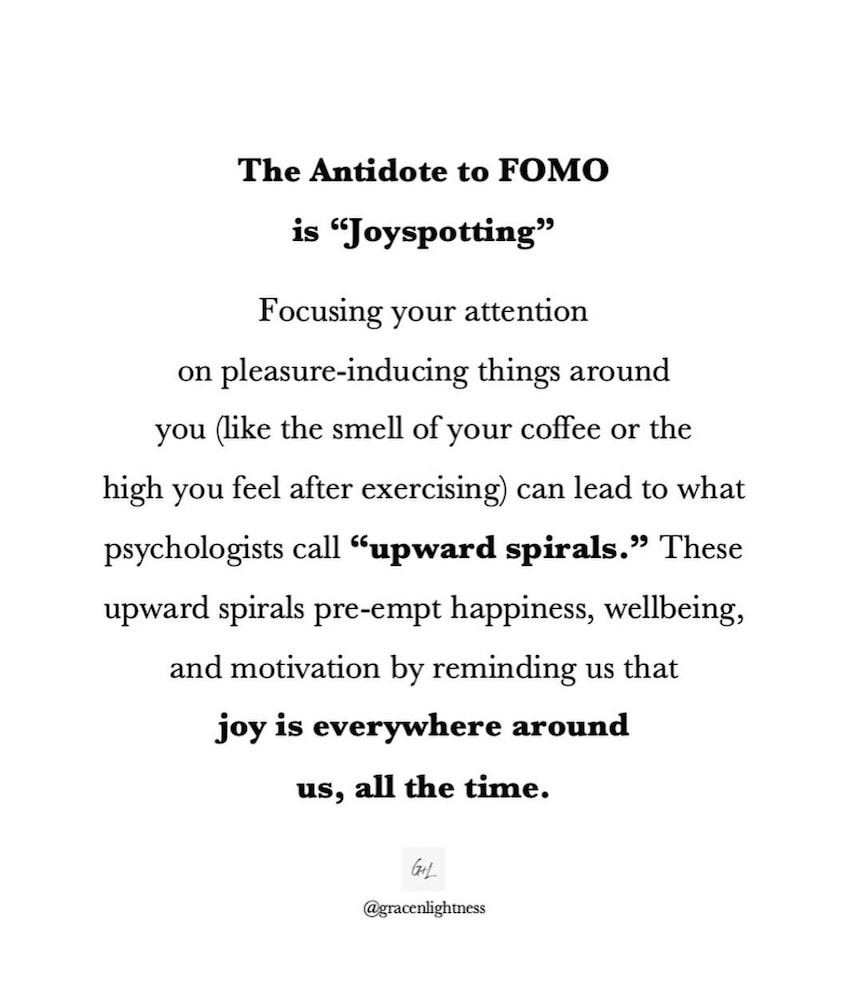When you’re stuck in a rut of negative thinking and feel like you’re headed in a downward spiral, making a conscious effort to redirect your depressive tendencies into an upward spiral can make all the difference. When you’re feeling down, self-care and conscious, effortful, mindful action become all the more essential.
But you probably already know that this is easier to say than do. If it were easy, you probably wouldn’t be feeling down in the first place. That’s life– but it doesn’t mean you have to settle for feeling this way!
There are a number of helpful mind hacks that you could try to lift yourself out of a downward spiral, but one that psychologists consistently stand behind is a practice often referred to as joyspotting.
Allow me to explain how it works, below.

“Joyspotting” is rooted in both the practice of gratitude and the phenomenon of selective seeing. And it can be a gateway to what is known as an “upward spiral”– a positive feedback loop that boosts your mood and overall wellbeing. (Yes, an upward spiral is the opposite of a downward spiral.)
Here’s how it works:
To lift yourself out of a depressive spiral– or to encourage a nature pick-me-up whenever you’re feeling own– focus your attention on pleasure-inducing things around you (like the enticing smell of your coffee or the mood boost you feel after exercising).
Consciously noting these positive experiences– aka “joyspotting”– can lead to what psychologists call “Upward Spirals”. These upward spirals encourage what is known as a “positive-virtuous cycle” versus “negative-vicious spiral”.
In a positive-virtuous cycle, your mind “tunes in” to good things naturally to initiate feelings of happiness, warmth, and wellbeing. This, in turn, improves focus, motivation, and overall mood.
In the same way, a negative-vicious spiral does the opposite. When you focus on the negative, your mind finds more reasons to selectively filter and notice negativity.
So, what’s the most practical and easiest way to ensure you sneak a bit of joyspotting into your day? Here are three key ways to encourage an upward spiral:

3 Ways to Practice Joyspotting To Encourage Upward Spirals
- First, try gratitude journaling daily. This is a practice of writing down 3 things that you are grateful for every day. These ideas don’t have to be big– in fact, the small the better. (That’s easier to do when you’re struggling.) You can do this either first thing in the morning when you wake up (keep a journal by your bed) or at night before you sleep. I like to gratitude journal right before bed as a reflection on the good things that happened that day. (This can also help you sleep better as it settles your mind before bed.) If you can’t think of anything, thank the universe that you are still breathing. (Seriously.)
- A second way to practice joyspotting is to write a note-to-self whenever you’re feeling happy. Keep a note on your phone that lists things you are excited about or encouraged by. Write down the things that make you happy whenever the feeling strikes. If you just discovered some new music that you love, for example, write it down. Then, whenever you feel like you’re headed in a downward spiral, consult this list and revisit these happiness-inducing ideas and activities. You may also consider making a Brag File to boost your mood. It works wonders!
- Lastly, and perhaps most effectively, try the 1-for-1 technique whenever you are gripped by negative thinking. 1-for-1 means that every time you have a negative thought, you have to match it with a positive thought even if you don’t believe it in that moment. For example, when I’m feeling scared/stressed during turbulence on a plane ride and I think, “Omg, what if this plane crashes??” I have to immediately ask myself, “What if the plane lands normally and everything is fine?” This, in turn, reminds your brain that positive thinking is just as valid as negative thinking. (And it’s important to practice this often, as the brain has a bias for negative thinking.)
Because joyspotting is an easy-to-apply mind hack, people use this as a technique to get over FOMO (aka fear of missing out), as well.
For example, if you are jealous of a friend’s vacation pictures on social media, think about your last vacation or the last cool thing you did. Focus on how fun it was, as much as you can. This might not promote a full-on upward spiral, but it can slow your descent into envy or self-loathing.
(Another thing to note about social media. It’s difficult not to compare our lives to other peoples’ “highlight reels”, so it’s worth remembering that people usually only share “the good stuff” on social media. There are two sides to every story. You never know what people are going through behind the scenes.)
It’s Not About Getting Rid of Negative Thoughts
The key in all of this is that you don’t need to stop your negative thinkings completely in order to experience an upward spiral. We get it; that’s very hard. You just need to juxtapose your patterned thinking with a few positive thoughts that naturally even out the balance. Make sense?
Every little bit of practice you can do to prevent negative thinking re-wires your neural pathways. This will help you ward off negative thinking in the future, as well. Like exercise, it works wonders for depression.
Ultimately, the same is true for joyspotting and upward spirals in general. If you practice joyspotting regularly, then initiating your own upward spirals becomes second nature over time.
Practice, as they say, makes perfect. And when you’re feeling down, a little bit of forced effort could make all the difference.
***
Related: Experiencing acute stress? Try this Helpful Grounding Exercise for Calming Spiraling Thoughts and learn How To Be Less Sensitive To Other People’s Emotions.
Also: 12 Things That Are Better Predictors of Happiness Than Money.
Need more help? Read This If You’re Having a Panic Attack.

Leave a Reply